Greg Bothun's image of the Coma cluster for comparison with Alan Dressler's HST data on Abell 851 at redshift z=0.4 graphically shows how spirals have vanished from clusters over cosmic time (part of the Butcher-Oemler effect).
There is a nice animated simulation of ram-pressure stripping removing gas from a spiral presented by C. Balkowski, B. Vollmer, and V. Cayatte.
Sequence of observations and conclusions, going back to about 1994:
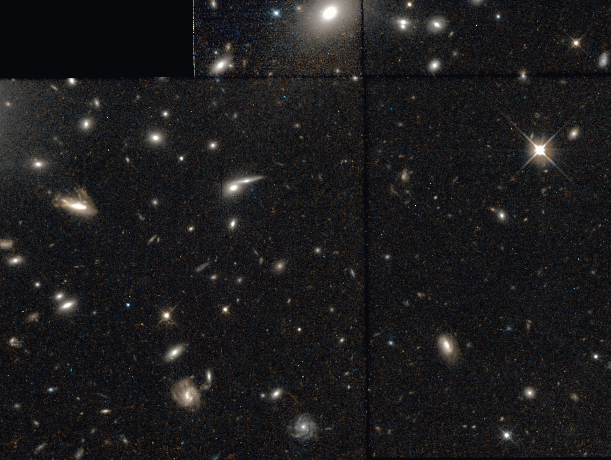
Above: the inner part of Abell 2125 from two-color WFPC2 imaging. The triple central galaxy is just off the left edge. C153 is the galaxy near the left side showing plumes of emission-line material (red).
Here are two displays of the same data now zoomed around C153 itself. Linear (left) and logarithmic stretches are both helpful in showing the inner chaotic dust structure and the plumes of star-forming regions extending up (more or less north) and to the left from it. These, in turn, are regions where other data suggest gas has recently been swept from the galaxy. If there isn't already a galaxy called the Flying Fish, this one will do.
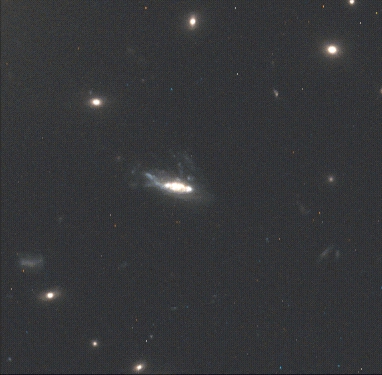 |
 |
Color composite images of Abell 2125 from the KPNO 4m Mosaic Imager. Available as JPEGS covering 3x4 arcminutes (a2125mos2.jpg) and, scrunched down, 6x8 arcminutes (a2125mos2wf.jpg); even that last one is only about 1/16 of the full field by area. Mark Hanna at NOAO has sent a trial TIFF of the cluster core after cleaning up the star-saturation artifacts. For your browsing pleasure, I've set up color composites of the entire 8000x8000 Mosaic field, at full resolution (12-Mbyte jpeg) or half-size (2.8-Mbyte jpeg). Getting these made required using both my workstation and laptop to cover for one another's shortcomings... This image shows the major clumps in Abell 2125 (there's another big group of galaxies in the 4 o-clock direction to the SW), plus interesting background clusters, foreground interacting galaxies, and the ubiquitous background of faint blue galaxies. And looking north during the summer, we were graced by the trails of not just one, but two, tumbling Russian SL-16 booster stages, that aren't quite completely eliminated in image stacking.
Now for the multiwavelength evidence as to what kind of bad things happened to this galaxy. The contours below are of [O II] emission from ionized gas, observed with the KPNO 4m and CCD Mosaic, overlaid on the HST V-band image (approximately emitted B band). This shows gas in a trail from the galaxy, which makes sense if it has passed through the center of the cluster's hot gas recently. The galaxy is part of a subsystem with redshift 2000 km/s higher than the main cluster (which likely has most of the X-ray gas seen by Chandra). This sure looks like gas stripping in action.
![[O II] contours on HST V image](c153oiionhstgx.jpg)
And for more excitement, the Chandra data by D. Wang et al. show not only the usual intracluster gas, but when windowed for soft X-rays only, show a trail from C153 matching the one seen in [O II] emission. These data are shown contoured in an overlay with the KPNO Mosaic blue-light image, since they extend well beyond the WFPC2 image borders. (This image already is full size, cribbed from a recent proposal):
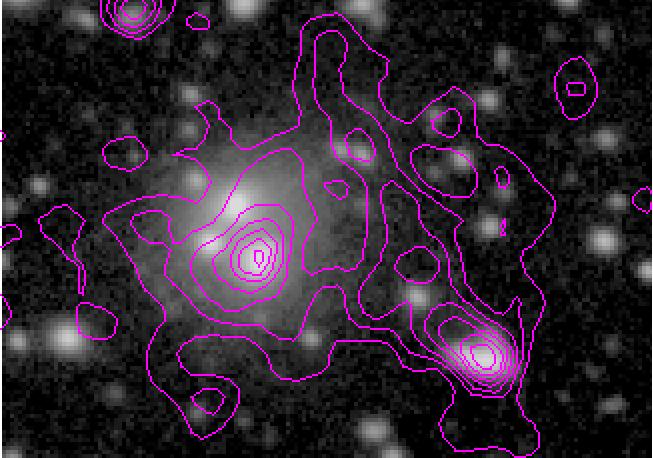
Here is the cluster core comparing optical galaxy light and the adaptivey smoothed X-ray structure. The low- and high-energy X-rays (split at 2 keV) are shown as blue and violet, superimposed on the visual image from the Kitt Peak Mosaic camera. This contrasts the hotter intracluster gas with the cooler gas in the tail of C153. Cooler by comparison with the 30 million K of the cluster core, anyway.
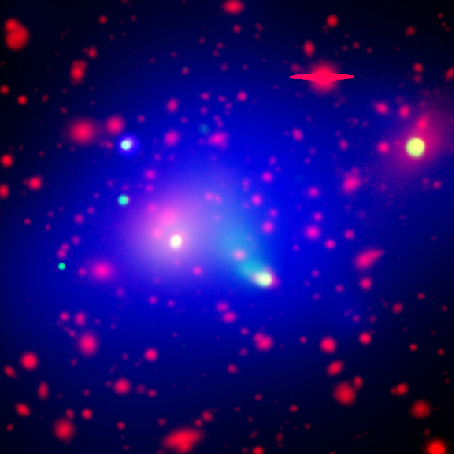
This just in: Frazer has straightened out some alignment issues, so here is an overlay of the highest-resolution VLA data on a color-enhanced version of the HST WFPC2 image. It now suggests that we may see radio emission along the minor axis, as one might expect from a starburst- or AGN-driven wind, as well as from star formation in the galaxy and the bright star-forming regions to the left (west) in the fishtail. The central radio source is best explained by an active nucleus.
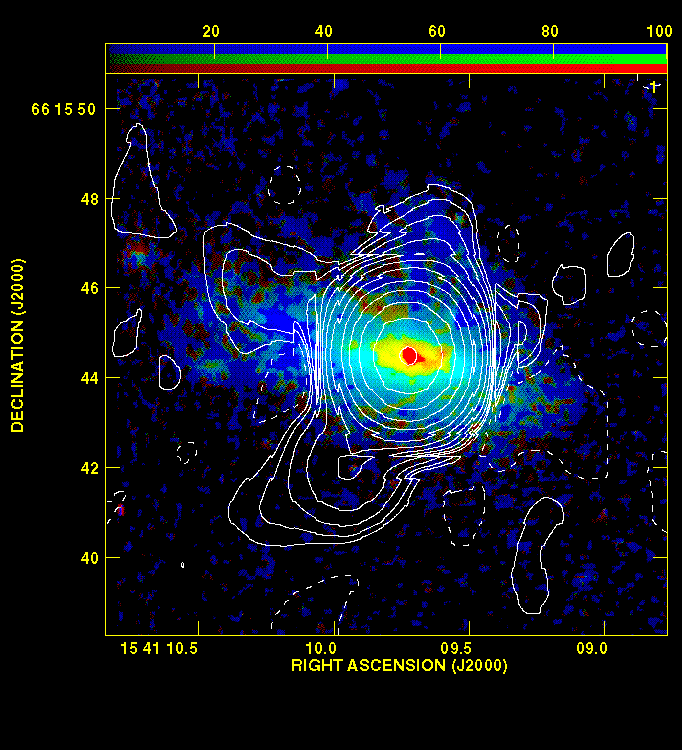
AAS abstracts:
Dense environments clearly foster the transformation of galaxies, but it has proven difficult to untangle the roles of various processes in cluster environments. We have found a uniquely strong case for ongoing stripping of gas from the galaxy C153 in Abell 2125. The cluster, at z=0.25, includes merging subsystems with a relative line-of-sight velocity near 2000 km/s. C153, identified using the VLA as a strong radio source powered by star formation, is the brightest cluster member with activity of this kind, and part of the less populous blueshifted grouping. Several lines of evidence indicate that it is being swept by a stripping event. (1) A tail of ionized gas is seen in [O II] emission, which extends at least 70 kpc toward the cluster core, coinciding with a soft X-ray feature seen in the Chandra observations reported by Wang et al. (2) HST WFPC2 images reveal disturbed and clumpy morphology, including luminous star-forming complexes and chaotic dust features. (3) The spectral energy distribution and Gemini GMOS absorption-line spectrum indicate a massive burst of star formation ~108 years ago superimposed on an older and much fainter population. (4) The stellar and gas kinematics are decoupled, with multiple gas velocity systems including counter-rotating components. The large velocity difference between the galaxy and (most of the) intracluster medium may contribute to the signatures being more prominent than hitherto seen. The starburst age is consistent with estimates of the time since the closest encounter of the major subsystems during the cluster-level merger. We continue to explore whether a starburst outflow or tidal damage has added to the role of stripping by the ICM, and how star formation has proceeded in the gas after leaving the galaxy disk.
This work was supported by NASA through HST grant GO-07279.01-96A, and by the NSF through facilities at NRAO, Kitt Peak, and Gemini-North.
And here's the Chandra abstract:
The structure of the universe is believed to have formed by clustering hierarchically from small to large scales. Much of this evolution occurs very slowly but at a few special times more, rapid, violent activity may occur as major subunits collide at high velocities. Abell 2125 (z=0.247) appears to be undergoing such an event as shown by modeling of the optical velocity field and by the detection with the VLA of an unusually large number of associated radio active galaxies. The core of the cluster contains four strong radio galaxies, one of which (C153) as imaged by HST shows a very peculiar, disrupted morphology and a radial velocity of 2000 km/s relative to the cluster mean. We present a spectacular 80 ksec Chandra imaging of Abell 2125. This X-ray imaging, together with extensive complementary multi-wavelength data (see the accompanied presentation), reveals for the first time the direct evidence for galaxy transformation and destruction during the cluster formation. The Chandra data unambiguously separate the X-ray contributions from discrete sources and large-scale diffuse gas in the Abell 2125 complex, which consists of various merging clusters/groups of galaxies and low-surface brightness emission. This enables us to study processes affecting galaxy evolution during this special time from scales of Mpc down to a few Kpc. On large scales, a patch of relatively prominent low-surface brightness X-ray emission has a significantly lower temperature metal abundance than in the Abell 2125 core cluster, characteristic of a group environment. At higher resolution, soft X-ray enhancements are found to be associated with bright radio galaxies in the core cluster. A distinct X-ray trail, in particular, appears on one side of C153 suggesting that the ISM is being stripped from this galaxy. The overall level of activity plus the special time for the cluster-cluster merger suggests that an important phase of galaxy evolution can take place during such events.
This work was supported by NASA through Chandra grant GO1-2126.
Here is a crude sketch showing the cluster merger, constituent galaxies, and trail of gas from C153. I had a little trouble getting the galaxies to fade to the background color; ignore the black moats around some of them. Here, deep blue is supposed to represent the hot cluster gas seen in X-rays, whose effect accounts for the loss of gas from C153. The Chandra data show that there is some large-scale lumpiness in this gas, attributable to the cluster interaction. [Ignore the cross effect on the galaxies too...] C153 likely passed very close to the center of the bigger cluster. From our point of view, the the foreground cluster's large central galaxy looks very close to the two big ones in the background. There is additional excitement in the form of stars pulled out of some of these galaxies by tidal forces. This is a half-size image; click for the full-size one.
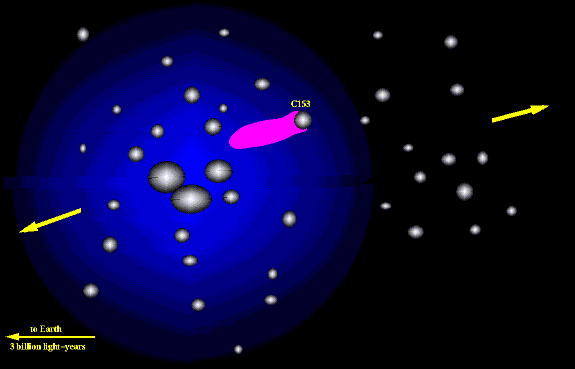
Some additional relevant links: